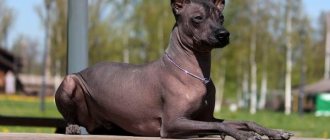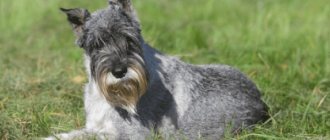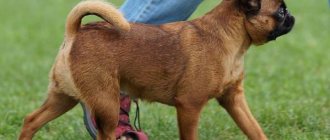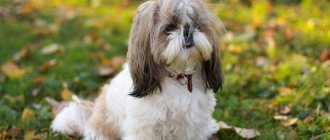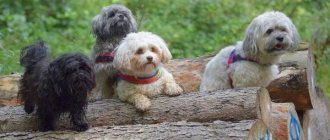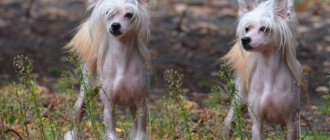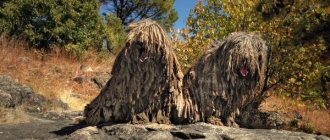The Newfoundland is a unique dog, which is also called a diver. Her impressive size and menacing appearance do not at all combine with her surprisingly good-natured character. These dogs have no aggression towards any living beings at all; they love to serve people and help those who are weaker. Because of this, the Newfoundland will not become a watchman or guard; it simply cannot bite a person. He is good-natured, sociable, obedient, affectionate and loyal. But before getting a dog of this breed, you need to study its description, pros and cons, and reviews from owners.
- Head
- Education and training
- Content Features
Description of the Newfoundland breed
Popularity 32nd among 263 dog breeds
Lifespan:
9-11 years
Height:
males: about 71 cm, females: about 66 cm
Country of origin:
Canada
Average price:
20-40 thousand rubles
Weight:
males: about 68 kg, females: about 54 kg
Latest articles Cat health
Rabies vaccination for cats: choice of vaccine, necessity, schedule 01/22/2022 4 0 0
Selection and adaptation
TOP 20 best cat breeds for families with children 01/22/2022 25 0 0
Key facts
The Newfoundland is a large, strong dog with an attractive exterior and a good-natured character. Serving people is the meaning of life for her.
It is unlikely that you will be able to look at representatives of this breed without a smile of tenderness. A bear dog can scare anyone with its size. But once you look into the four-legged eyes, you will immediately feel his kind heart and generous disposition.
The description of the Newfoundland breed mentions the origin of the name. It is related to the island of Newfoundland, located in the eastern part of North America and belonging to Canada. Other abbreviated names for the dog are diver, newf.
Newfoundlands are loved not only in their country of origin, but throughout the world. Such fame became possible thanks to the docile nature, incredible loyalty to the owner, courage and extraordinary appearance of the animal. Reviews from owners speak of them as an inexhaustible source of love, happiness and devotion.
There are often references to their use as companions during long expeditions. They also took part in combat operations, helping orderlies drag the wounded. The characteristics of the Newfoundland breed say that due to their enormous size, the dogs can act as rescuers.
Females are slightly smaller than males in all respects. Their weight reaches 54 kg, while males weigh about 68 kg. The height at the withers of females reaches 66 cm, the height of male Newfoundlands is up to 71 cm. The life expectancy of Newfoundlands is short, only 9-11 years.
Application
Newfies are born rescuers, they swim well, pulling the victim to the shore, they are not afraid to jump into the water from a boat, or swim to a drowning person with a life preserver.
Strong dogs, they can easily tow a boat; in the north they are actively used for transporting heavy loads on sleds.
But still, their main purpose is to be a companion dog, a friend for the whole family.
The Newfoundland is, first of all, a rescue dog, accustomed to making decisions and acting independently in critical situations.
History of the origin of Newfoundlands
There are many stories about the appearance of this breed. Unfortunately, most of them are far from the truth.
Many cynologists call the ancestors of Newfoundlands the European bear-catching dogs that lived in the Middle Ages. These Berenbeiters arrived on the island on the Scandinavian ship of the Viking Leif Eriksson around the year 1000. Over time, the descendants of the dogs went wild and turned into huge black dogs with long shaggy hair. This is how the first Europeans saw them when they arrived here in the 16th century.
Professor from Switzerland Albert Heim talks about the origin of the breed from Molossians - mastiff-like dogs similar to mastiffs. They were brought to the territory of modern Canada from England during colonization.
Large black and piebald shepherds are also cited among the possible ancestors of the breed. They also mention white Pyrenean mountain dogs, brought by settlers from Spain and Portugal.
Most Canadian scientists believe that Newfies descended from local sled dogs used by Eskimo tribes. This version is supported by the pet’s increased friendliness and its determination to always come to the aid of a person.
The first written mentions of dogs appeared at the very beginning of the 18th century. There is a known name associated with a large settlement on the island: the dog of St. John. Even then they mentioned their excellent working qualities, good nature, and ability to swim or dive well.
The British began to export these animals, and then started breeding them. Two types of dogs were created: retrievers and Newfoundlands. The name was last given by George Cartwright in 1775.
At the beginning of the breeding process, black and white individuals were used for mating, then preference was given to quadrupeds only black in color.
The breed became popular in the second half of the 19th century. It was then that the fashion for large dogs appeared in Great Britain. At the exhibitions of those years in Birmingham, Newfies were a great success. Giants became pets of noble people. So, in 1864, the Prince of Wales’s pet won first place at a competition in England.
Since 1878, Newfoundlands have been included in the Kennel Club stud book in Great Britain. Then clubs of lovers of these bear-like individuals began to appear. In 1885, such a place was opened in the USA. In Russia, the first divers began to be found at the beginning of the last century among the pets of aristocrats. After 1945 they were brought from Germany.
Soviet dog handlers took part in improving the working qualities of Newfoundlands. They were bred with shepherd dogs to make them more aggressive. But such experiments were not successful.
Price
The cost of puppies of this breed varies depending on their purebred, availability of all necessary documents and the opportunity to participate in future exhibitions (or raise breeding offspring).
Depending on the above reasons, the price of puppies ranges from $350 to $2000.
The Newfoundland is a dog that can be an excellent watchdog, rescuer, nanny and companion. If you follow the rules for the care, training and feeding of these animals, one of the best and smartest dogs in the world will live in your home.
Newfoundland appearance
General impression
Divers are very similar in color and size to bears. This powerful individual has an athletic build and a luxurious fur coat. Despite its large size, the dog has good control of its body. The latest exterior standards appeared in 1996, at which time they were enshrined in the description and photo of the Newfoundland. All dogs that did not match them were discarded.
Head
Large, with a wide skull and slightly protruding vault. The bump on the back of the head is clearly visible. The Newfie's muzzle is short, almost square in shape, and completely covered with short, silky hair. There are no folds, the cheeks are soft to the touch. The color of the nose corresponds to the color of the pet and can be black or brown.
The Newfoundland's jaws are very powerful, with large white teeth. The bite resembles a scissors. Small, wide-set eyes are dark brown with a light tint. Small ears are located closer to the back of the head, they look like triangles with round tips.
Neck
The Newfie's thick neck is covered with strong muscles, but it is also very mobile. There is no pronounced dewlap on this part of the body, and it is quite long. It is the neck that helps maintain the majestic posture of the animal's head.
Torso
The body of the Newfoundland is large, strong, but compact. The length of the body from the beginning of the withers to the tail is equal to the length of the withers to the floor. The dense and wide back and croup look very solid. The chest, together with the lower back, has strong muscles. The bottom line is completely flat. In females, the body is more elongated and less massive compared to males.
Forelegs
According to the standards, the front legs should be parallel and straight. The shoulders are well developed and directed back. The pasterns are slightly inclined.
Hind limbs
The hind legs are characterized by well-developed hips and long, strong shins. The pasterns on the hind legs are set low, but do not protrude in or out. Rounded feet correspond to the size of the body. The claws are black in black animals and pink in brown ones.
Tail
The diver's tail is wide in itself and flared at the base. It acts as a rudder if your four-legged friend is swimming. In a standing position, the Newf's tail is slightly lowered with a noticeable bend. You can't have him on his back or tucked between his legs.
Movements
The giant moves with powerful sweeping movements. The back remains straight. During tireless running and acceleration, the pet places its limbs close to the middle.
Wool
The hard, waterproof coat appears smooth with a perfectly acceptable wavy pattern. The undercoat with a hard structure becomes even thicker in winter. Most noticeable in the chest and croup areas. Feathers are visible on the Newfoundland's paws.
Color
The colors of Newfoundlands are not very diverse. Black is the most common pet color. In summer, slight fading is possible. Brown color can be chocolate or bronze shades.
Black and white individuals are also present among divers. In this case, white becomes the main one, and black can be the head, the base of the tail, and part of the croup.
Size
The height of females is about 66 cm, males - 71 cm. The weight of female Newfoundlands is 54 kg, males - 68 kg. The size of Newfoundlands requires that they be kept in a spacious house or kennel.
Newfoundland character
Representatives of this breed have an easygoing character. They are very tactful, loyal, friendly and kind dogs. Their presence in the house will create an atmosphere of warmth, calm and safety.
Socialization of four-legged giants occurs from their very birth. All they need is to be useful to a person, to serve him. They are capable of heroic deeds and can provide assistance in almost any situation.
Newfoundlands have proven themselves excellent in working with the military or police, as guards or guide dogs. Even diver puppies are not capricious; they do not make noise or bark for no reason. As adults, dogs are very smart and resourceful. They can form opinions about something and even ignore meaningless commands.
At the same time, the Newf understands when his help is needed. To save a person, he does not need orders. Here he himself can calculate everything, make a decision and react. This indicates the high intelligence of the animal.
Despite its large size, it is easy for a diver to adapt to life in a city apartment or in a country house. He will not disturb you with his presence if he understands that his company is currently undesirable. The pet enjoys going on country walks in the car, without creating noise or fuss.
Giant dogs love children very much and are ready to play with them all day long. At the same time, parents can be calm about their children, because not only will they not be offended, but they will also monitor their safety.
The Newfoundland will also find contact with other pets. Even if they don’t become close friends, they will definitely respect each other.
The pet becomes attached to its owner for life. He distinguishes a person’s mood well by a person’s intonation, and is ready to do anything for him. When a family changes, the pet will accept new owners, but its heart will be broken.
Due to their good-natured nature, Newfoundlands cannot be called good watchdogs. They do not have lightning-fast aggression towards a stranger. But, having analyzed the situation and sensing danger, they will attack with all their enormous power.
Basic moments
- A distinctive feature of the breed is its passion for water. Newfoundlands are capable of diving, making long swims, and are unsurpassed rescuers of drowning people.
- Newfoundlands are characterized by high socialization and genuine heroism. Many animals serve in the police, military units, and work as guides.
- Dogs are very friendly and enjoy interacting with people, including strangers.
- Newfoundlands behave on equal terms with adult family members. Children are treated patronizingly, protected and patiently endure annoying harassment.
- They are attached to other family pets: from parrots to cats. They do not experience aggression towards strangers and try to establish friendly relations.
- The goodwill of the Newfoundland will not allow him to be a guard dog; he does not have an innate aggressive reaction to strangers; he needs time to assess the situation. However, sensing danger to family members and homes, these dogs quickly fight back the enemy.
- They have high intelligence, excellent memory, quick wit, and are amazingly able to predict the desires of the owner.
- Representatives of the breed are polite and delicate, but they absolutely cannot stand criticism towards themselves, and do not tolerate shouting or rude orders. Physical punishment of these dogs is unacceptable; the insult will leave an indelible mark on their memory.
- Newfoundlands are characterized by a measured lifestyle, they are not too mobile, so their activity should be stimulated. The best way is to provide them with the opportunity to swim and play in the water.
- They need regular care for their luxurious thick coat.
- Adapted to life in city apartments, but it is desirable that the room area be larger than average. The ideal conditions for keeping a Newfoundland are a country house near a pond.
The Newfoundland is a dog you can't pass by without smiling. Her powerful forms and “bearish”, somewhat frightening appearance are not able to hide her generous heart and kind disposition. Excellent character, self-esteem, incredible kindness, devotion, courage, expressive majestic appearance - these are the virtues that brought these dogs world fame. They are the heroes of many literary works, reports, participants in dangerous expeditions and military operations. Newfoundland in a family is always an inexhaustible source of joy, warmth and love.
Education and training
Conducting training with Canadian breed animals is a pleasure. They have a sharp mind, they grasp everything on the fly. From puppyhood, the dog understands everything immediately and even without fully listening to a requirement or command, strives to fulfill it.
We must remember to use a calm tone when giving orders and patience. We must not forget to encourage the pet, who, having felt the approval of the owner, will take up work with redoubled force, will readily and willingly respond to a request or order.
Before you start training a dog, a young Newfoundland is taught:
- to the rules of hygiene;
- respond to your nickname;
- walk on a leash.
Training exercises can be carried out at any time of the year. Due to the characteristics of their coat, they are quite comfortable in any weather. You need to alternate between group training and individual training. It’s great if the Newfoundland is raised and trained under the guidance of a trainer or an experienced dog breeder. A well-bred giant will delight its owner throughout its life.
Training
The need to educate dogs of this breed from childhood is well understood by their owners. When the dog grows to its natural size, not everyone can move it from its place or direct it in the right direction. Therefore, the dog must know and follow all basic commands.
Training puppies and older Newfoundlands is quite simple, and even a novice dog breeder will be able to cope with training his first pet of this breed. Animals have excellent memory, as well as a high level of intelligence, and they always try to please their owner, so they are easy to train.
But you should remember about the main character traits of such a pet - their innate slowness and phlegmatism, therefore, when giving a command, you should not expect that the Newfoundland will carry it out at the same second - this dog needs time to think. You cannot scold your pet for such slowness!
It is best to train Newfoundlands in special areas under the guidance of an experienced instructor who will tell you how to properly train this large pet.
With proper training, by the age of one year, a grown-up diver will know all the necessary commands.
Newfoundland Health and Diseases
Possible diseases
Newfies can be called strong not only for their appearance, but also for their state of health. Indeed, pets rarely get sick, although they live only 9-11 years. The main reason for their diseases is body weight, which creates problems with the musculoskeletal system.
Due to the large build, your pet may develop hip dysplasia. This is a hereditary incurable disease that manifests itself at different ages and leads to lameness.
Panosteitis, or inflammation of the long bones, is also a common disease in large breed dogs.
Many health problems can be caused by poor diet or overfeeding of a diver. We are talking about problems with intestinal function, flatulence, food allergies, and obesity. Excess weight can cause heart problems.
Bred in cold climates, dogs do not tolerate heat very well and may suffer from heat stroke. Its signs include lack of appetite, lethargy, and a dry and warm nose.
Routine and preventive vaccinations against a number of diseases help maintain good health: rabies, hepatitis, enterovirus, parainfluenza, distemper, salmonella, leptospirosis. Complex vaccination is carried out at 1.5 months, then repeated at 2 months, six months and a year. After 12 months, vaccinations against a complex of diseases are given annually.
Reproductive health
Puberty in females occurs at 10 months. From this age, it is possible to perform an operation to sterilize a dog, but it is not yet ready to give birth to healthy offspring.
Mating is carried out during the third heat, which occurs at 20 months of the bitch’s life. Mating is carried out on the territory of the male dog, and it should be quite large for the future parents to be comfortable.
Features of feeding and diet
Feeding the powerful Newfoundland should be balanced and moderate due to its tendency to overeat and become obese.
When choosing dry food, owners do not have problems enriching the dog’s diet with additional vitamin and mineral complexes. This type of food should be purchased premium or holistic.
Natural food must contain at least 50% protein. These can be lean varieties of beef, lamb, rabbit, meat by-products or sea fish fillets. The meat is given in boiled, minced form in combination with porridge or vegetables. The best cereals for Newfoundlands are rolled oats and buckwheat, but it is not recommended to include rice, pearl barley or millet in the menu.
From the age of one month, puppies begin to be fed with low-fat fermented milk products, cottage cheese, boiled eggs, and oatmeal. It is useful to add grated carrots, cabbage and greens to your food. We must not forget about clean water.
Sometimes it is useful for a diver to have fasting days. On such days, which are held no more than once every two weeks, dogs are given rye bread crackers, boiled or raw vegetables.
Prohibited products include:
- sweets and chocolate;
- flour products;
- pork, poultry;
- salted, smoked or spicy;
- potatoes and berries with seeds.
The Newfie's menu should be varied, but feeding from the master's table or allowing food to be picked up from the ground is prohibited. This can lead to food allergies and gastrointestinal problems. Therefore, you cannot respond to a pleading look with a request for more or a tasty piece from the owner’s plate.
Puppies up to 6 months are fed about 5-6 times a day. As the dog grows and matures, the number of feedings is reduced to 2 times. It is considered correct if the dog leaves the bowl clean after feeding. Otherwise, the nutritional intake is reduced.
Care and maintenance
Newfoundland dogs feel equally comfortable in open space and in city conditions. Divers do not shy away from cars or pursue them. They are not familiar with such deviations in behavior.
But keeping giants in small apartments is not worth it. They are better suited for living space in medium-sized high-rise buildings or a country house with its own plot. Ideally, there will be a body of water near the house in which the pet can swim to its heart’s content. It is not worth keeping a diver in an enclosure, much less putting him on a chain, because he will be sad due to the lack of communication with the owner and members of his family.
Newfies must be given a separate place where they can rest or sleep comfortably. This could be a small mattress or bed with an orthopedic base. The dog doesn't run around the house or chew furniture, so you don't have to worry about repairs.
Pets need active walking on a leash in the city or without it in parks and open areas. The walk is carried out at least twice a day, if possible in the morning and evening.
Newfoundlands require regular and quite complex care. Long-haired dogs are brushed with a stiff brush at least three times a week. If this is not done or not done too often, the Newfie’s fur will roll into tangles, which will cause itching and dermatitis of the skin. It is best to carefully unravel the discovered tangle.
Twice a year, the pet’s thick undercoat is renewed. This molting occurs in autumn and spring. During this time, the fur is combed every day. You can contact a groomer who will give you a haircut that will make it easier to care for the giant’s hair.
The pet's hard fur, impregnated with a special lubricant, does not require frequent washing. Dirt and moisture do not penetrate the skin, but the use of various shampoos worsens the condition of the coat. So bath days can be arranged only a few times a year.
Once a month, it is recommended to trim your Newfoundland's nails using clippers and a nail file to handle uneven areas. To prevent inflammatory processes, his ears and eyes are periodically wiped from accumulated dust and dirt. To do this, use chamomile decoction, special drops and lotions, or chilled boiled water.
Keeping and caring for a Newfoundland will be a joy if you teach the dog to hygiene procedures from childhood.
Main characteristics
Nature has endowed Newfoundland dogs with the best qualities:
- No hostility. The main goal of creating the breed was to find a mate who could work faithfully and diligently next to his owner. Due to excessive kindness, the Newfie's watchdog qualities leave much to be desired, but the dog will always come to the rescue thanks to his natural courage and heroism. The breed's flexibility allows it to get along well with other animals on the farm.
- Loyalty - from a young age, the puppy becomes attached to the entire family in which he lives. Excessive affection makes it difficult to endure a change of owners; in a new family, the dog can become withdrawn.
- Love for children. A child can do almost anything with a Newfoundland - such endurance and endurance can be envied.
- Curiosity. Dogs are interested in transport; traveling seems to them to be an entertaining and unusual activity. Dogs of this breed love to be part of everything exciting.
- Calmness and endurance. Sometimes Newfoundland dogs can come across as inert, lethargic or even indifferent animals. But the opinion about the dog will change when the owner accidentally finds himself in danger - then the dog suddenly transforms into a fast and formidable bundle of muscles.
- Intelligence. Thanks to his remarkable memory and amazing intelligence, the dog is easy to train. Often the dog is able to decide on its own what the right thing to do is, not paying attention to the owner’s instructions.
Tips for choosing a puppy
Only when purchasing a Newfoundland puppy from a nursery can you be sure that the standards of exterior and pedigree of the future pet will be met.
When making a choice, ask to see the baby’s parents, observe his behavior and feeding. You can purchase a pet 45 days after birth. But a four-month-old puppy should already have a veterinary passport with information about vaccinations against a range of diseases and rabies.
A small pet should look like a miniature copy of an adult. He should be energetic, inquisitive, strong. A healthy puppy's coat is shiny, looks clean and free of tangles. But you need to understand that the price of a pet with a pedigree will be quite high.
Newfoundland puppies look cute, so you should choose based on the behavior of the future family member.

